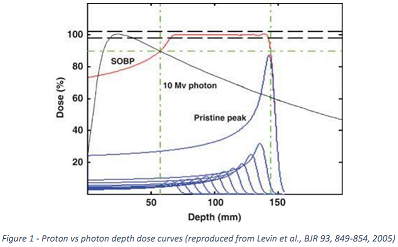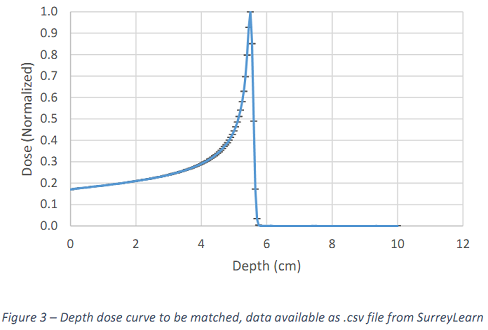Reference no: EM132255659
FLUKA Assignment -
This assignment should be submitted as a report based on results obtained using FLUKA.
Introduction - Proton and hadron therapy have received a lot of press in recent years offering an alternative to conventional therapies (such as X-rays, gamma-rays and electron beams) with benefits such as improved healthy-tissue sparing and depth control arising due to the energy deposition curve known as the Bragg peak as shown in Figure 1 - Proton vs photon depth dose curves (reproduced from Levin et al., BJR 93, 849-854, 2005).

Due to the limited numbers of machines available in the UK and worldwide Monte Carlo modelling offers a vital tool for investigating this technology for dosimetry, treatment planning, shielding and a whole host of other applications.
Your Assignment -
During treatment it is usually necessary to deliver dose over a range using a spread out Bragg peak (SOBP) in order to fully treat the region of interest. This can be achieved through a number of mechanisms such as varying the energy of the proton beam at source, i.e. the treatment machine, or by reducing the machine energy using an intermediate material placed before the patient, such as a range modulation wheel.
Your assignment is to create a model whose Bragg peak depth matches that of a supplied Bragg peak curve (csv file available on SurreyLearn) and then to investigate the two mechanisms of reducing the depth (reducing energy and using a PMMA block) in order to achieve a series of given target depths.
Your Report -
Your results should be presented as a brief report including a short background to explain what FLUKA is, how Monte Carlo works and any pertinent equations relevant to explain your work to someone of scientific but not radiation science background. You should include enough detail so that someone could repeat your results without being too verbose.
Your results should include the initial energy required to match the provided Bragg peak curve as well as a series of thicknesses and energies to achieve the given target depths. Note that you should be using energy OR PMMA rather than the two together to achieve the required depths. You should include details of simplifications and/or approximations in your models with comments to their potential impact. All results should have uncertainties where possible.
You should submit your report on SurreyLearn along with a copy of your input file and flair file, these should be submitted as individual files and not as archives/compressed archives.
Geometry
The beam is a monoenergetic 1 cm x 1 cm plane parallel proton beam located 10 cm from the front face of a 20 cm x 20 cm x 20 cm water tank as shown in Figure 2. Any PMMA blocks can be simulated directly before the water tank and should have sides of 5 cm x 5 cm, thicknesses to be determined.

The nominal beam energy of the provided depth dose curve is 80 MeV and you are told that the machine has variations of up to 5 MeV from this value. Finally, you are required to find the beam energies and thicknesses of PMMA such that the Bragg peak maxima lie at 45 mm and 40 mm of water.

Report - Around 4-5 pages + Analysis.
Attachment:- Assignment Files.rar